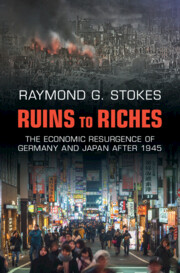Book contents
- Ruins to Riches
- Ruins to Riches
- Copyright page
- Dedication
- Contents
- Charts and Figures
- Acknowledgements
- Introduction
- Part I No Mere Incantation
- Part II Making Miracles, 1950–1973
- Part III Sustaining Miracles, 1973–1989
- 7 The Wages of Construction
- 8 The Hauntings of the Past
- 9 Fragile StrengthCoping with Currency and Oil Crises
- Part IV Navigating Waves of Globalization, 1990 to the Present
- Notes
- Index
9 - Fragile StrengthCoping with Currency and Oil Crises
from Part III - Sustaining Miracles, 1973–1989
Published online by Cambridge University Press: 12 April 2024
- Ruins to Riches
- Ruins to Riches
- Copyright page
- Dedication
- Contents
- Charts and Figures
- Acknowledgements
- Introduction
- Part I No Mere Incantation
- Part II Making Miracles, 1950–1973
- Part III Sustaining Miracles, 1973–1989
- 7 The Wages of Construction
- 8 The Hauntings of the Past
- 9 Fragile StrengthCoping with Currency and Oil Crises
- Part IV Navigating Waves of Globalization, 1990 to the Present
- Notes
- Index
Summary
After 1945, the United States took unprecedented levels of responsibility for leadership of the capitalist world economy, offering the dollar as the anchor for world currencies, championing free trade, and setting the standard for the consumer society, to which most other countries aspired. Related to that, it also acted as pacesetter in the adoption of petroleum-based fuels. For three decades, the system championed by America seemed to work well, not least for the West Germans and the Japanese. Suddenly, however, everything changed. US President Richard Nixon ended the Bretton Woods system in 1971, ushering in floating currency exchange rates. Two years later came the first of two oil crises that buffeted global trade and economies. The Germans and Japanese must have felt that, instead of entering a US-style Garden of Eden of earthly delights, they had instead been led down the garden path. The impact of these crises involved unaccustomed negative current account deficits for both countries through the early 1980s. However, reduced use of energy, changes in the energy mix, and highly successful export drives soon led to a pronounced recovery. These surpluses have generally remained positive ever since, although at far more modest levels in Japan than in Germany.
- Type
- Chapter
- Information
- Ruins to RichesThe Economic Resurgence of Germany and Japan after 1945, pp. 183 - 202Publisher: Cambridge University PressPrint publication year: 2024



